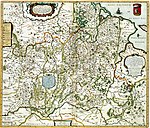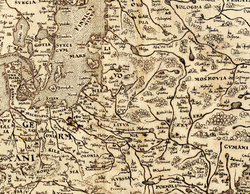Lithuania proper
| History of Lithuania |
|---|
 |
| Chronology |
|
|
| History of Belarus |
|---|
 |
| Prehistory |
| Middle ages |
| Early Modern |
|
| Modern |
|
|
|



Lithuania proper (Latin: Lithuania propria, literally: "Genuine Lithuania"; Lithuanian: Didžioji Lietuva; Yiddish: ליטע, Lite) refers to a region which existed within the Grand Duchy of Lithuania, and where the Lithuanian language was spoken.[1] The primary meaning is identical to the Duchy of Lithuania, a land around which the Grand Duchy of Lithuania evolved. The territory can be traced by Catholic Christian parishes established in pagan Baltic lands of the Grand Duchy of Lithuania subsequent to the Christianization of Lithuania in 1387. The Lithuania Proper (Lithuania Propria) was always distinguished from the Ruthenian lands, the Lithuanians differed from the Ruthenians in their language and faith (Paganism in the beginning and Catholicism since 1387).[2][3][4] The term in Latin was widely used during the Middle Ages and can be found in numerous historical maps until World War I.[5]
Lithuania proper sometimes is also called Lithuania Major, particularly in contrast with Lithuania Minor.
Evolution of the term[]
Before the Grand Duchy of Lithuania[]

Historians designate Lithuania Proper (or Land of Lithuania in a narrow sense) as a Lithuanian land that existed prior to Grand Duchy of Lithuania, near other lands: Land of Nalšia, Land of Deltuva, Land of Upytė. According to Henryk Łowmiański, Lithuania Proper was in nucleus of future Trakai Voivodeship between rivers: Nemunas, Neris and Merkys. Tomas Baranauskas suggests[6] that Lithuania Proper was around Ašmena area, ethnic Lithuanian lands in modern Belarus. According to Mikola Yermalovich (although his reliability is questioned by other scholars[7][8]) Lithuania (Belarusian: Летапiсная Лiтва, literary: Lithuania of chronicles) was in the upper Neman region,[9][10] now in modern Belarus.
In the Grand Duchy of Lithuania[]
Scholars often use term Lithuania proper to refer to lands inhabited by ethnic Lithuanians[11] as opposed to lands controlled by the Grand Duchy of Lithuania inhabited by Ruthenians (ancestors of modern Belarusians and Ukrainians), Russians, Poles, Lithuanian Jews or many other nationalities.[citation needed] Already during the Grand Duchy times, Lithuania Proper was a term designated to land where Lithuanians live.[12] Administratively it consisted of Vilnius Voivodeship, Trakai Voivodeship and the Duchy of Samogitia.[13] This division continued even after Polish-Lithuanian Commonwealth was partitioned.[14] Thus Grand Duchy of Lithuania was divided into such historical regions: Samogitia, Lithuania Proper and Ruthenia.
Eastern part of Lithuania Propria[]
For centuries, eastern and southern lands of this territory, that had direct contacts with Ruthenia and Poland, initially inhabited by ethnic Lithuanians were slowly Ruthenised, Polonised and Russified, and the Lithuanian-speaking territory shrunk. Eastern parts of Lithuania Propria suffered heavy population losses during the Deluge, and further on during the Great Northern War and following plague epidemic in 1710–1711. Subsequent immigration of Ruthenians and Poles into these territories accelerated the process. A significant push to the de-Lithuanisation ensued when Lithuania became a part of the Russian Empire, and especially, after Lithuanian language books were forbidden to print in Latin letters in 1864. The process continued at the time of Polish rule, as Lithuanian language schools and libraries were closed, and later under Soviet rule, as no Lithuanian schools were in these territories at all. Nowadays significant "islands" of Lithuanian-speaking people remain in eastern and southern parts of Lithuania proper (modern Western Belarus (see ) and Northern Poland (see Punsk). Many people of these territories now speaking Belarusian still refer to themselves as Lithuanians.[15]
Modern developments[]
At the end of World War I, the Council of Lithuania declared an independent Lithuanian state re-established in the ethnic Lithuanian lands.
After negotiations with Bolshevik Russia a large part of Lithuania Proper was acknowledged by Soviets as part of Lithuanian Republic by signing the Soviet-Lithuanian Treaty of 1920. Some of these territories were also claimed by Second Republic of Poland. This led to series of military conflicts and eventually to war.
In 1943, Antanas Smetona (in exile at the time) began working on a study "Lithuania Propria".[16] The book was dedicated to the history of Lithuanian lands before Polonisation, Russification, and Germanisation hoping that it would help to substantiate a claim to unreturned territories in a peace conference after World War II. His work was left unfinished, and for a long time was available only as a manuscript and was virtually unknown.[17]
Currently the Republic of Lithuania has no territorial claims.[18]
See also[]
References[]
- ^ Stone. Polish-Lithuanian state, 1386-1795. p.4
- ^ "Legacy of Medieval Lithuania". Retrieved 26 September 2020.
- ^ Гаучас П. К вопросу о восточных и южных границах литовской этнической территории в средневековье // Балто-славянские исследования. 1986. М., 1988. С. 195, 196.
- ^ Safarewicz J. Studia językoznawcze. Warszawa, 1967. S. 257-259
- ^ [1]
- ^ Baranauskas, Tomas (2002). "Kur buvo Lietuvos žemė?" (PDF). Lituanistica. 2: 3–18. Archived from the original (PDF) on 2007-09-28.
- ^ Gudavičius, Edvardas (1996). "Following the Tracks of a Myth". Lithuanian Historical Studies. 1: 38–58.
- ^ Насевіч В.Л. Працэс утварэння Вялікага княства Літоўскага (13-14 стст.) // Актуальныя пытанні гісторыі Беларусі ад старажытных часоў да нашых дзён. Мн., 1992. С. 54-63.
- ^ Виктор Верас. "Карта летапiснай Лiтвы". Archived from the original on 2011-07-23. Retrieved 2010-10-05. (in Belarusian)
- ^ Виктор Верас. "У истоков исторической правды / Летописи о местонахождении Литвы". Archived from the original on 2010-10-08. Retrieved 2010-10-05. (in Russian)
- ^ Venclova, Tomas. "Native Realm Revisited: Mickiewicz's Lithuania and Mickiewicz in Lithuania". Archived from the original on 2005-05-05. Retrieved 2007-04-24.
- ^ (1981). Litewska granica etniczna na wschodzie od epoki plemiennej do XVI wieku (in Polish). Wydawn. Nauk. Uniwersytetu im. Adama Mickiewicza. pp. 69–73. Retrieved 2006-04-26.
- ^ (in Lithuanian) Viduramžių Lietuva Viduramžių Lietuvos provincijos Archived 2007-04-19 at the Wayback Machine. Retrieved on 2007.04.11
- ^ Authentic maps showing Lithuania Propria:
"Poloniae Regnum ut et Magni Ducatus Lithuaniae Accuratiss" (PDF). Retrieved 2007-04-22.
"Poloniae Regnum ut et Magni Ducatus Lithuaniae Accuratiss" (PDF). Retrieved 2007-04-22. - ^ Savukynas, Viriginijus (2003). "Etnokonfesiniai santykiai Pietryčių Lietuvoje istorinės antropologijos aspektu". Kultūrologija. 10: 80–98. Retrieved 2007-12-11.
- ^ Smetona, Antanas. "Lithuania Propria". Darbai ir dienos (in Lithuanian). 2 (11): 191–234.
- ^ . "Istorija ir politika". Darbai ir dienos (in Lithuanian). 2 (11): 185–190.
- ^ (in Italian)Claudio Carpini, Storia della Lituania: identità europea e cristiana di un popolo, Città Nuova, 2007, ISBN 978-88-31-10341-1, p.199
External links[]
- The map of the ethnic groups of the eastern Poland in 1921, after Norman Davies, God's Playground: A History of Poland: Volume II, 1795 to the Present; Columbia University Press: 1982
- Historical regions in Lithuania
- Metropolitan or continental parts of states


